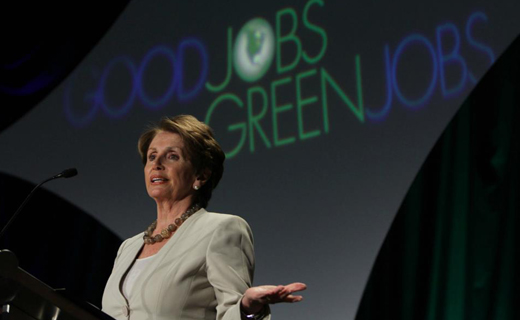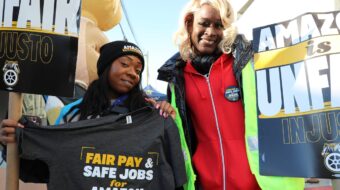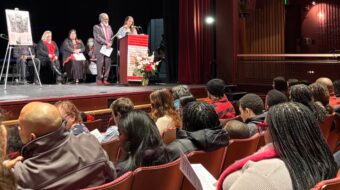
WASHINGTON – Unionists and environmentalists face common enemies – in corporate suites and Congress – and must get out of the “silos” of concentrating on their own issues and unite in a wide-ranging coalition, leaders of both groups say.
And in a panel discussion at the opening session of the latest “Good Jobs, Green Jobs” conference, in D.C., on April 15, they also laid out what Steelworkers President Leo Gerard called “low-hanging fruit” as initial goals.
Those are easily achieved successes, at the state and local levels where unionists and environmentalists can win through joint action, organizing and agitation.
The conference occurs as unions, environmentalists and the Obama administration continue under sustained, bitter, unyielding and merciless attack both from ruling Republicans on Capitol Hill and in the states and from corporate CEOs intent on driving wages, benefits and working conditions – including environmental conditions – down.
In one example of the success of those foes, Gerard pointed out that Gov. Tom Corbett, R-Pa., elected in the 2010 GOP tidal wave, revoked his Democratic predecessor’s pro-environment policy telling the state to invest in “green energy” plants.
“That cost us 1,200 members when Gemasa had to shut down,” said Gerard, referring to the Spanish-owned windmill/generator manufacturer that had opened a Steelworker-organized factory in western Pennsylvania.
But panel members, including Gerard, Communications Workers President Larry Cohen, Service Employees Vice President Mike Fishman and BlueGreen Alliance Executive Director Dave Foster – a former Steelworkers official – admitted that too often the two groups of activists concentrate on their own issues alone, to their loss.
“We need to quit trying to be everything to everybody,” Gerard told a standing-room-only crowd of conference attendees at the Washington Hilton. “Instead, we need to look for the low-hanging fruit” where both can cooperate.
“If you do what you always did, you’ll get what you always got,” he added. Union leaders at the AFL-CIO had to learn that the hard way, Gerard said, admitting they can’t win labor’s top cause – workers’ rights via enactment of the Employee Free Choice Act – just by union lobbying alone.
Similarly, he pointed out, environmentalists cannot win their top causes, such as U.S. participation in international efforts and treaties to reduce carbon emissions, by themselves. The two forces need each other, Gerard declared.
“If we can get beyond our boxes and understand that we and our communities are all impacted by economic injustice and environmental injustice, that those who are causing it are the same corporations and the same politicians, then we’ll work together,” Fishman added.
The Steelworkers and the Sierra Club took the lead in such joint efforts six years ago, forming the BlueGreen Alliance, the annual conference’s sponsor. But actual joint campaigns have been rare. And there have been roadblocks, speakers admitted.
One of them is the proposed Keystone XL pipeline, from the Montana-Canada border to the refineries of the Texas Gulf Coast. The pipeline would transport hundreds of thousands of barrels daily of “heavy” oil from the tar sands of Alberta to the plants for conversion into gasoline and other petroleum products.
Environmentalists are dead set against Keystone. They say it would increase carbon emissions and poison groundwater with leaks and spills. Unions are split on the issue. Building trades unions – which are not part of the BlueGreen Alliance – strongly lobby the Obama administration to approve Keystone. Other unions oppose Keystone.
That should not stop the unions and environmentalists from uniting, especially on the state and local levels as well as nationally, for both positive steps that help the environment and create jobs and against their common foes, Cohen and Gerard said.
Cohen gave two examples, one national, one local. The national example he touted is the coalition of 51 organizations, including unions and environmental groups, in the CWA-led “Democracy Campaign” for voting rights, the right to organize, immigration reform, evicting money from politics and breaking the GOP minority’s stranglehold on the Senate.
The local example he cited is in the port of Los Angeles, where “a strong central labor council” and the Teamsters backed an environmentalist campaign to empower the port’s truck drivers against environmentally hazardous working conditions. In return, the environmentalists supported the drivers’ right to organize.
Harvesting other “low-hanging fruit” could enthuse the two groups’ members, whom Gerard called “angry” at Obama and congressional inaction on their issues. One example would be a campaign to environmentally retrofit public buildings, starting with schools, providing jobs for union members. Another would be work to update the U.S. power grid, where line leakage now costs 7-15 percent of all electricity.
Photo: Nancy Pelosi speaks at the Good Jobs, Green Jobs 2013 conference in D.C. Good Jobs, Green Jobs Facebook page












Comments